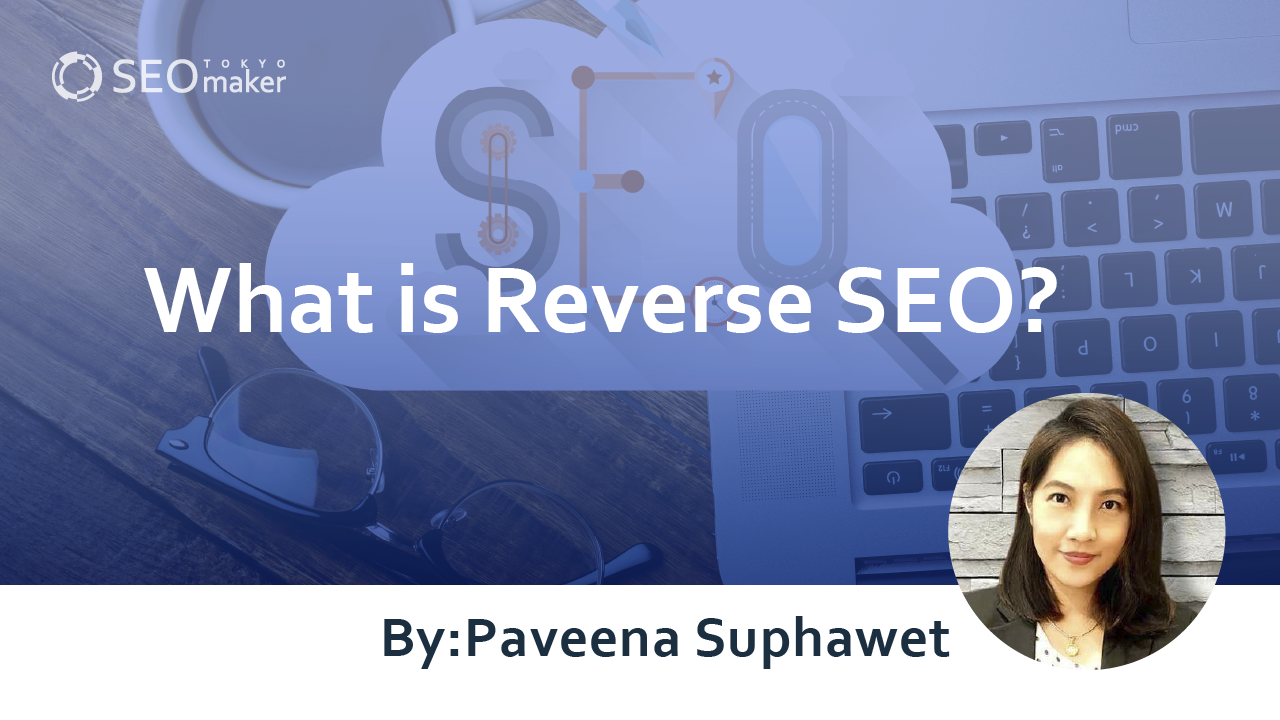What is Reverse SEO? Explaining the Basics and How to Handle It
contents

SEO aims to elevate the ranking of a company’s web pages, increasing touchpoints with potential customers. However, if a potential customer encounters negative comments or defamation about the company on other websites, it can have detrimental effects.
By lowering the ranking of such harmful pages, you can protect your company’s brand and product benefits.
In today’s era, even minor mistakes or flaws related to a company’s products can be easily taken out of context and spread via social media.
Implementing reverse SEO measures to not leave unreasonable negative ratings unaddressed is crucial knowledge for protecting your products and services in the long term.
I will delve deeper into reverse SEO, which will occupy a more significant position in web marketing going forward.
What is Reverse SEO?
Reverse SEO involves tactics aimed at pushing down web pages that are ranking highly for certain keywords to lower positions. Unlike conventional SEO, which aims to elevate the rank of a company’s own site, reverse SEO primarily targets lowering the ranking of other sites.
The demand for reverse SEO is particularly high in the recruitment sector. This is because the domain power of company review sites aimed at job changers is strong, and searches like ‘company name reviews’ often result in these review sites appearing at the top of search results.
A common confusion arises with ‘suggest pollution,’ which is different from reverse SEO. Suggest pollution refers to the phenomenon where negative compound words like ‘company name black company,’ ‘company name worst,’ or ‘company name power harassment’ become more likely to appear in search suggestions. It differs from reverse SEO, which aims to lower the ranking of web pages themselves, so it’s important to distinguish between the two.
Reference: What is Suggest Pollution? Explaining the Causes and How to Counteract (Removal Methods)
The Objectives of Reverse SEO
There are two main objectives of reverse SEO.
- To protect against reputational damage
- To outperform competitors
I will explain below.
Protection from Reputational Damage
For instance, if web pages containing slander, bad reviews, false information, or baseless claims rank highly for searches like ‘product name reviews,’ it can cause reputational damage.
Reverse SEO is primarily used to prevent damage from negative information. Typical SEO can only promote a company’s own web pages to a higher rank. Companies need to balance offense and defense, including reverse SEO, to sustain their business healthily.
Reverse SEO can be considered a form of risk management in web marketing.
To Outperform Competitors
If a competitor’s site ranks higher for keywords that are relevant and have significant volume for your potential customers, reverse SEO might be employed to deliberately push down these competitor sites.
By lowering the ranking of competitor sites on search engines, your site’s relative rating increases, allowing it to rank higher for the same keywords.
However, some agencies engage in illegal or ethically gray reverse SEO practices, leading to ongoing issues for companies that find themselves targeted by such actions.
It’s crucial to be aware that reverse SEO can be both employed and experienced, so keep this in mind.
How Reverse SEO Works
The mechanism of reverse SEO involves intentionally lowering the search ranking of a specific web page for a particular keyword.
Reverse SEO does not involve manipulating the target page itself. Instead, the page’s search ranking is lowered through external actions while the target page remains unchanged.
In other words, anyone can perform reverse SEO on a web page without altering the content of that page.
The process involves external actions that decrease the search engine’s evaluation of the target web page. SEO strategies include on-page (internal) and off-page (external) optimizations. Reverse SEO exploits off-page SEO tactics to lower the target page’s ranking.
Reference: What is SEO? A Complete Guide to SEO Strategies and Search Engine Optimization [2023 Edition]
Methods of Reverse SEO
First, let’s discuss ethical reverse SEO methods. Ethical reverse SEO involves improving the rankings of your own content pages, which subsequently lowers the rankings of competitors’ websites.
There are two legitimate ways to conduct reverse SEO to lower the rankings of competing web pages
- Creating competitive content
- Acquiring high-quality backlinks for your site
Let’s explain these in detail.
Creating Competitive Content
By creating high-quality content that ranks higher for specific keywords than the target web page, you can naturally lower the ranking of that page.
Factors such as word count, readability, page load speed, uniqueness, and effective HTML tags are important like standard SEO practices.
Reference: What is Content SEO? A Complete Guide (2023 Edition) – Key Points, Benefits, and Success Stories
Acquiring High-Quality Backlinks for Your Site
By creating competitive content and acquiring backlinks from strong domain sites, you can lower the search rankings for specific keywords.
If there are two web pages with similar content, the one from a website recognized by search engines as having a higher domain authority will rank higher.
Increasing high-quality backlinks to your site and its pages can be an effective way to conduct reverse SEO on a specific page.
Reference: Introducing Backlink Checker Tools! What Are Backlinks Important for SEO?
Gray or Black Hat Reverse SEO Techniques
There are gray and black hat methods in reverse SEO. While these methods are not recommended, being aware of them can help you identify and address potential attacks if you become a victim.
Here are five methods.
-Increasing backlinks from low-rated sites
-Creating a large number of duplicate sites
-Launching cyber attacks
-Filing DMCA claims
-Posting fake reviews on MEO (Map Engine Optimization)
Increasing Backlinks from Low-Rated Sites
By increasing the number of malicious backlinks to the target web page, search engines may begin to see that page as associated with spammy sites.
Malicious backlinks, also known as spam links, include links from link farms, directories with poor content, or low-quality blog posts.
This method is relatively easy to execute, making it one of the most common forms of reverse SEO attacks.
Reference: What Are Spam Links? Explanation of Identification Methods, Countermeasures, and Impact on SEO
Creating a Large Number of Duplicate Sites
Another method involves creating numerous copies of the target web page’s content and publishing them across various domains. Search engines might struggle to identify the original content, potentially mistaking the original page for duplicate content and lowering its ranking.
Additionally, the presence of extensive duplicate content might lead search engines to devalue the content itself, thus lowering the ranking of all associated pages, which supports the reverse SEO effort.
Launching Cyber Attacks
Cyber attacks can degrade the user experience and site performance, causing search engines to lower the site’s evaluation, contributing to reverse SEO.
Examples include DOS (Denial of Service) attacks and DDoS (Distributed Denial of Service) attacks, where large amounts of data are sent to the site or server, making it difficult to access the site. If network delays occur, the site’s page load speed, a critical SEO metric, will significantly deteriorate.
Filing a DMCA Claim
Filing a DMCA (Digital Millennium Copyright Act) claim involves requesting the removal of web pages that infringe on copyright. Google accepts DMCA claims continuously, and there are instances where a targeted web page is excluded from search results through this method.
Additionally, if there is content on a different page of the targeted website that seems to infringe copyright, filing a DMCA claim can lower the overall value of the site in the eyes of the search engine. Even if the page isn’t removed, a decrease in the site’s overall value can lead to a drop in search rankings.
Reference: What is DMCA? Explaining How to Handle Digital Millennium Copyright Act Violations
Posting Fake Reviews on MEO
As a reverse SEO tactic, using MEO (Map Engine Optimization) can be effective when users search for a company name. Search results often prominently feature Google Maps results.
Within the Google Maps business information section, there is a ‘Reviews’ area. If these reviews are significantly negative, users may opt to trust and research information from a different page rather than the company’s own page.
This naturally decreases the click-through rate for the company’s page. Search engines may then interpret this as a lack of interest in the company’s page, potentially lowering its ranking.
Many external methods exist to lower the search rankings of specific web pages, and as search engine algorithms are updated, new reverse SEO techniques continue to emerge.
By understanding that SEO knowledge often overlaps with reverse SEO knowledge, you can maintain safer web marketing practices.
Reference: What Are the Differences Between SEO and MEO? Detailed Explanation on Which to Prioritize
How to Handle Reverse SEO Attacks
Here are six ways to address reverse SEO attacks.
- Rewrite your content
- Improve user experience
- Create satellite sites
- Request content removal
- Hire reverse SEO specialists
- Consult with a lawyer
Rewriting Your Content
Consider reverse SEO attacks as an opportunity to revisit and improve your site’s SEO.
Rewriting content is highly effective. If a significant amount of time has passed since the content was originally posted, the demand for specific search terms may have changed.
Enhance the content to meet user needs with adequate information and rephrase it to maintain engagement. This can improve search engine evaluations.
When the effects of gray or black hat reverse SEO diminish, your search rankings can increase, leading to higher profits and enhanced brand reputation compared to before the attack.
Reference: What is Content Rewriting? Steps and Tips for Improving SEO Effectiveness
Improving Usability
Improve user experience
Google emphasizes user convenience as a top priority in its policy ’10 Things We Know to Be True.’ Enhancing site usability can lead to higher rankings in search results and serves as an effective measure against reverse SEO attacks.
There are many ways to improve usability, such as modifying title tags, compressing images, and removing unnecessary scripts.
For websites with high mobile traffic, it is especially recommended to use PageSpeed Insights to improve the mobile score.
Reference: What is Usability? Explaining Its Impact on SEO and the Difference with Accessibility
Creating Satellite Sites
Even if the rankings of a site affected by reverse SEO are restored, the offending website may still hold a reasonably high position.
In such cases, creating satellite sites that rank highly for targeted keywords can be beneficial. The more satellite sites you have, the more likely the offending site’s rankings will drop.
These satellite sites should have different designs and themes, with targeted keywords included in the articles or pages. Additionally, if these satellite sites receive backlinks from high-authority domains, their rankings can improve even further.
Moreover, satellite sites can generate their own value and become new sources of traffic. Creating satellite sites can serve multiple purposes beyond just countering reverse SEO.
Reference: Basics of Satellite Sites! Purpose, How to Create, and Case Studies
Requesting Content Removal
Investigate the operator of the web page being used for reverse SEO and, if possible, contact them to request content removal. If the reverse SEO is being conducted by an individual within the organization rather than as a company policy, they may respond positively to a removal request.
If the operator’s information is unavailable, you can use ‘Report Content on Google’ or ‘Report for Legal Reasons’ to request removal.
Hiring Reverse SEO Specialists
Engaging a company specializing in reverse SEO can provide swift and comprehensive support. These specialists are often SEO professionals and can significantly improve your website while addressing reverse SEO.
For cases requiring a combination of approaches, such as content optimization, exclusion requests from search engines, and suggest pollution countermeasures, hiring a specialist firm can be highly effective.
Consulting a Lawyer
If legal expertise and procedures are required that specialized reverse SEO companies cannot handle, it is advisable to consult a lawyer to resolve the issue.
The downside of consulting a lawyer is the cost and time involved. The more complex the reverse SEO issue, the higher the costs. Additionally, legal procedures often take a significant amount of time, even when handled efficiently.
When consulting a lawyer for reverse SEO issues, ensure they have experience dealing with reverse SEO cases.
Overall, countermeasures against reverse SEO involve improving the quality of the managed site, creating supportive satellite sites, filing removal requests, and consulting specialized companies or lawyers in a step-by-step approach.
Frequently Asked Questions About Reverse SEO
Q: What is Reverse SEO?
A: Reverse SEO is a web marketing tactic that intentionally lowers the search ranking of a specific web page for a particular keyword. It is also known as reverse SEO or anti-SEO, as it is the opposite of regular SEO practices.
Q: What does reverse SEO involve?
A: Reverse SEO involves creating content similar to the page you want to lower in rank, and applying internal and external optimization strategies so the new page ranks higher than the targeted page.
One approach is to get backlinks from highly rated sites to the new page, which helps it rank higher than the target page.
Q: What are the methods of reverse SEO?
A: There are white hat methods that improve the SEO ranking of other web pages and gray/black hat methods that disrupt the targeted page’s ranking.
White hat methods include improving the quality of the web page’s content, enhancing HTML tag structures, increasing backlinks, and improving usability to increase dwell time.
Gray and black hat methods include adding a large number of low-quality spam links to the targeted page, creating many duplicate sites, launching cyber attacks to overload servers, and filing false copyright infringement claims.
Q: Can I do reverse SEO myself?
A: Yes, you can conduct reverse SEO yourself. By creating new websites or web pages and applying both internal and external SEO strategies, you can achieve higher rankings than the target site and effectively handle reverse SEO in-house.
Q: How much does reverse SEO cost?
A: The cost of hiring a specialized reverse SEO company typically ranges from tens of thousands to hundreds of thousands of yen per month. Starting with a lower-cost plan and adjusting the services and strategies based on search result trends can help achieve cost-effective reverse SEO.
Summary
As various web platforms emerge and SEO mechanisms continue to evolve, reverse SEO techniques will also advance. By maintaining knowledge of reverse SEO alongside SEO, you can minimize risks to your managed sites. Regularly checking for the impact of reverse SEO is crucial. Knowledge of reverse SEO serves as a protective web marketing strategy, ensuring the stability and benefits derived from your website.










![What is a Description? Explaining the Meaning, Writing Style, and Changing Word Count – [2023 Edition]](https://www.switchitmaker2.com/en/wp-content/uploads/2024/09/what-is-description.webp)










